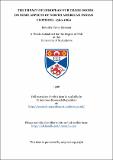Files in this item
The impact of European fur trade goods on some aspects of North American Indian clothing, 1560-1860
Item metadata
| dc.contributor.author | Craw-Eismont, Beverley | |
| dc.coverage.spatial | xxxii, 396 p. | en_US |
| dc.date.accessioned | 2018-06-21T15:32:08Z | |
| dc.date.available | 2018-06-21T15:32:08Z | |
| dc.date.issued | 1996-07 | |
| dc.identifier.uri | https://hdl.handle.net/10023/14423 | |
| dc.description.abstract | This thesis examines the impact of European trade goods on some aspects of North American Indian clothing. Sources include historical archives, artefacts, and artistic representations as well as the conclusions of archaeologists and anthropologists. Part One considers the beaver fur trading background. Geographically, the area extended from the northern Atlantic seaboard, through the St. Lawrence River and Great Lakes, the northern Plains and into the Canadian Subarctic. The native population included Northeast Woodland, Plains, and Athapaskan/Subarctic peoples. European goods entered at different periods and varying rates. French and British traders depended for success upon the established trade network and the extensive goodwill of the Native American population. They found it essential to determine by trial and error and "market research" the types of goods which the experienced Indian consumers would accept in exchange for their furs. The Indians were discerning in their selection of items and made critical choices which have been under-rated or over-looked in the literature of the fur trade. In the past they were often represented as simple, passive and willing to accept any trifles which came their way. In fact, European men often adopted Indian clothing appropriately suited to the environment. They also carried popular items of Indian manufacture to trade alongside imported wares. Additionally, Indian traders expected that Euro-Americans would participate in their pre-existing reciprocal ceremonial bartering practices. Since cultural values differed widely they needed to find mutually accommodating methods for dealing with each other. Part Two, based extensively on artefactual examples examines the impact and influence of introduced trade goods, and to some extent French and British "styles" on Native American clothing manufacture of hats, coats, and shoes. Decorative materials such as cloth, blankets, ribbons, silverwork, braids, laces, and beads were adopted and ingeniously used in often unique ways. Steel needles, scissors, awls and knives came to play an important part in skin preparation. The potential of new materials was skilfully realised but elements of existing technological practise continued. It is difficult to establish a case for Indian dependency when acceptance of introduced items, contrary to Eurocentric accounts, was by no means wholesale. There was instead, a mutual inter-twining of cultures. In fact, trade goods were often used in conjunction with native materials and sometimes rejected altogether. Careful creative choices were made regarding such factors as colour, lustre, and sound. Trading was seldom a simple procedure since there were sometimes hidden nuances. Goods could fulfil expressive symbolic, magic, prestige or status functions poorly recorded and comprehended by Europeans. Paradoxically, far from becoming dependent or Europeanised, in the days of the declining fur trade, it will be evident from this thesis that Native Americans produced clothing which became flamboyantly ever more distinctive and innovative as their three hundred year period of usefulness in their own right to Europeans as fur traders ended. | en_US |
| dc.language.iso | en | en_US |
| dc.publisher | University of St Andrews | |
| dc.subject.lcc | E98.C8C8 | en |
| dc.subject.lcsh | Indians of North America--Clothing | en |
| dc.title | The impact of European fur trade goods on some aspects of North American Indian clothing, 1560-1860 | en_US |
| dc.type | Thesis | en_US |
| dc.contributor.sponsor | Russell Trust | en_US |
| dc.type.qualificationlevel | Doctoral | en_US |
| dc.type.qualificationname | PhD Doctor of Philosophy | en_US |
| dc.publisher.institution | The University of St Andrews | en_US |
This item appears in the following Collection(s)
Items in the St Andrews Research Repository are protected by copyright, with all rights reserved, unless otherwise indicated.

